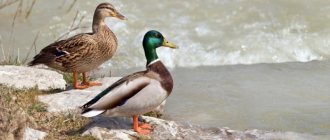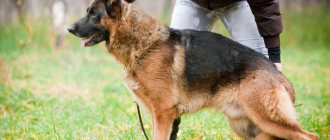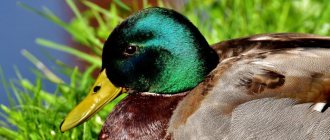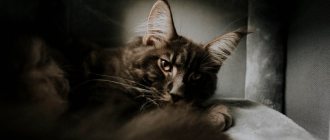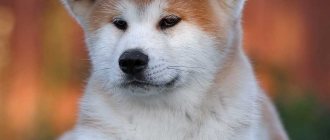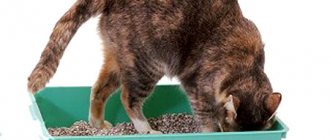What color is the carp fish?
Carp are large fish that are brown or yellow-green in color. Although the color of carp may vary depending on its habitat. The body of the carp is elongated and covered with large golden-brown scales. There are carps with virtually no scales.
Interesting materials:
What do bees produce besides honey? What did Raskolnikov bring to the old woman? What does roller skating develop? What does this law regulate? What to plant in July? What to plant after potatoes? What to plant in the shade of a house? What to plant in a greenhouse in August? What to plant along the fence at the dacha? What counts as a bus?
Is it possible to give frogs to domestic ducks?
The digestive system of domestic ducks differs little from that of their wild counterparts. They also easily get used to eating fish, whole or crushed, and various plants.
Some farmers even specifically collect algae and coastal plants to feed the birds.
And you should be careful about frogs. And here are the reasons:
- In nature, the duck feeds on amphibians in extreme cases.
- Poultry meat will acquire a specific swamp smell if you feed it everything.
At the same time, for variety and to increase egg production, during the molting period, it is sometimes allowed to give domestic ducks caught or purchased frogs.
Nutritional Features
All types of frogs are tireless in obtaining food. What does a frog eat? It is known that the grass frog eats approximately 1,300 insects - pests of gardens and vegetable gardens - over the entire summer period. And the sharp-faced one exterminates many pests, including stink bugs and beetles, which even birds avoid.
As a rule, frogs forage for food during the day, and toads destroy pests mostly at night and at dusk.
Certain species of these amphibians
Lake frog is one of the largest species of this class of amphibians; in adulthood it can reach up to 17 centimeters in length. It is widespread throughout the world and can withstand fairly high temperatures up to about 40 degrees. What do frogs of this species eat? They are omnivores; they eat all the small animals that exist in the vicinity of the reservoir.
Tiger frog , a representative of this species is mainly distributed in India; like the lake frog, it grows up to 17 centimeters in length. What do these amphibians eat? Almost all of them can eat small mice, insects, and they can also eat snakes.
The slingshot frog is a fairly large amphibian; in adulthood it can reach up to 25 centimeters in length; its main habitat is considered to be South America. It is primarily an insectivore, but in its natural environment it can feed on other species of amphibians. Its body is almost round, and it got its name because of the horn-shaped protrusions on its head. Because of its unusual appearance, many naturalists keep them at home, and for it to feel great in captivity, it is enough to put a pool in the terrarium for it. Since she, unlike her relatives, loves to swim, and also needs fresh food and vitamins containing calcium.
Bullfrog , due to its size of 25 cm and weight in adult form up to 600 grams, it bears this name. But on farms in Asia, where they are specially bred for meat, they can reach one kilogram. This is a fast and agile individual, nocturnal, which is what bullfrogs eat: they are omnivores, like tiger frogs, and prefer to wait for their prey in ambush. In China, the meat of these amphibians is considered a delicacy and is sold as luxury meat. However, it takes two years for her to reach a good weight.
The Goliath frog is the largest species and can reach 32 centimeters in adulthood, but is currently on the verge of extinction. She prefers only clean water for her residence, and the slightest contamination forces her to leave her habitat. It feeds like all its brothers, but being larger in size, it is less agile and easy to catch. Local aborigines use it for food and sell it to expensive restaurants as gourmet meat. All attempts to breed this frog in captivity have not led to positive results.
Tadpole food
Female frogs lay their eggs on algae, hanging them in the form of long threads. After a certain time, tadpoles hatch from the eggs, leading a fish life - they swim in the water and breathe through gills. Frog larvae feed mainly on plant foods:
- seaweed;
- Tina;
- soft parts of underwater plants;
- ciliates.
Some species of tadpoles are predators and feed on crustacean larvae or insect eggs.
How and what does a person eat
The human body needs regular energy replenishment. It is renewed thanks to the various nutrients contained in foods. These include:
- proteins;
- carbohydrates;
- fats;
- mineral salts;
- vitamins;
- water.
Proteins are complex organic substances. A person's daily diet should consist of one third of foods high in protein. When broken down in the body, they replenish energy reserves. Proteins are of plant and animal origin. They are found in foods such as meat, poultry, dairy products, fish, seafood, nuts, legumes, and grains.
Carbohydrates are natural organic substances consisting of carbon and water. They are divided into complex and simple. Foods containing complex carbohydrates are considered healthy. It retains a feeling of fullness for a long time and is digested gradually. Complex carbohydrates are found in vegetables, citrus fruits, berries, legumes, apricots, apples, pears, millet, pearl barley, oatmeal, and buckwheat.
Food containing simple (fast) carbohydrates is easily digestible. It leads to a sharp increase in blood sugar. If a person eats too much of these foods, it leads to unhealthy weight gain and the development of other diseases. Simple carbohydrates are found in candies, waffles, cakes, sweet pastries, some fruits, and potatoes.
Fats and fat-like substances are called “lipids”. They retain and accumulate energy in the body. Contained in oils, lard, avocado, olives, fish.
What is the difference between a toad and a frog?
Toads are larger than frogs. ... Frogs have smooth, greenish skin. Toads live on land, while frogs spend most of their time in water. The hind legs of toads are shorter than those of frogs, because they move by crawling and only in rare cases make short, awkward jumps.
Interesting materials:
In what year did the Kremlin walls turn red? In what year did African countries gain independence? In what year were high-rise buildings built in Moscow? In what year did the Curies discover radioactivity? In what year were the Curies awarded the Nobel Prize for their discovery of radioactivity? In what year did Surgut become a city? In what year was Sverdlovsk renamed to Yekaterinburg? In what year did Tatarstan join Russia? In what year did the Titans attack Wall Maria? In what year did Titov fly into space?
Life of a frog in nature
The frog tadpole feeds on microscopic algae, and a little later on insect larvae. Frogs reach sexual maturity in the third year of life. Their life expectancy in natural conditions reaches 6-12 years. With the onset of cold weather, frogs go to winter, preferring to bury themselves in the mud. Sometimes they can hide on land, for example, in a rodent hole. For example, grass frogs spend the winter at the bottom of ice-free reservoirs, at the headwaters of streams and rivers, gathering in tens and hundreds of individuals. For wintering it chooses cracks in the earth's crust.
Toads and tree frogs: differences
Toads are characterized by a lack of teeth and bumpy skin that is darker and drier than a frog's. The world's largest individual, the aga toad, is also one of the most poisonous among its fellows.
Its weight can reach 2 kg. The smallest toad is 2.4 cm long. Representatives of this species prefer to live on land, going down to the water only during the mating season.
Tree frogs are the smallest representatives of the three described frog species. They differ from the others by the presence of expanded discs on their fingers, which help them climb up. Some species can fly, which helps them escape from enemies.
Types of food chains
In nature, most often there are 3 links in the animal food chain. But there are other schemes with more links. There are always predators at the top of the chain. At its very end there is a superpredator who has no enemies in the wild. It could be, for example, a white shark, a brown bear or an Amur tiger. Typical circuit diagram:
- The first link in the chain is plants or protozoa (single-celled organisms). Absorb the energy of sunlight, decomposing residues in the soil and beneficial substances found in nature. Plants or bacteria do not need to eat anything directly.
- The second link is animals that feed on these protozoa or microorganisms. This series includes herbivores: insects and rodents, birds and fish.
- The third link is predators. They eat those who eat plants. If a mouse feeds on grain, then there is someone who hunts it: an owl, a marten or a snake.
Connection between flora and fauna
A standard example of a food line: plant - hare - fox. The hare eats the bark of trees, and the fox hunts and feeds on rodents. No one eats the fox, since it is born a predator and ends up at the top of the row. Note that the representative of the strong link is above everyone and eats the weaker one. Man is considered the highest level; he obtains animals in the process of hunting. There are two chain models:
- Eating chain, or grazing. Starts as a green or woody plant and consists of three or five organisms. In the process of life, some animals, small in size, eat grass and tree leaves, while others feed on these animals. Example: oats - hare - fox.
- Chain of decomposition. It starts with dead organic matter. The links are decomposing food products and the organisms that consume them. Example: fallen leaves - earthworm - nightingale - hawk or rotten mushroom - slug - frog - duck - wolf.
In nature, organisms are closely related to each other. Plants, fungi, animals and birds live in community. If even one link falls out of the nutritional scheme, it becomes a threat to everyone. Because they simply won’t find food for themselves. Example: plantain - caterpillar - mole - hawk.
It would seem that it is much more pleasant to live without mosquitoes, snakes and frogs. But they seem to be important links in the food line. Without insects, amphibians and predators, the ecological balance would be disrupted. It turns out that all organisms are equally important and necessary.
Examples of food line models
The food line of insects has its own differences. This sequence includes two links of insects, when a butterfly or aphid, which is familiar to the human eye, is eaten by more massive predatory insects - ground beetle, dragonfly, spider. And the already large winged ones become food for small rodents like mice or hare, or amphibians such as frogs. Example: chamomile - aphid - dragonfly - lizard - snake - heron.
The feeding model in animals consists of 3–5 links. Warm-blooded animals that feed on grass, seeds, leaves and tree bark are called herbivores. Those who eat winged and six-legged animals are called insectivores. Larger prey is hunted by predators, for example, wolves and foxes are carnivores. There are also omnivores - they eat plants and other living or dead organisms. Example: nut - squirrel - mink - fox.
Finding frogs for fishing
Frogs are found in almost any freshwater body of water - the only difference is in the number and size of individuals. If you are not lucky enough to stock up on bait in advance, you can easily catch it on the shore. The frog prefers to be in thick grass, hide in sedge, reed thickets, thicker coastal vegetation, under stones or tree branches that have fallen into the water. Most often, you don’t really need to look for it - the baby frogs either jump out at your feet when you walk along the shore, or report their location with a loud “kwa-kwa”. You can catch frogs with a net, your hands, or any rag you can find, simply throwing it over potential bait.
Tips for catching frogs
- During the summer season, the easiest time to catch a frog is early in the morning or after sunset. During the daytime, all types of frogs usually hide in thick grass or water.
- In cold weather, frogs move to shallow water, where they lie down under stones or sheltered holes.
- To use frogs as bait, you should take small young frogs with a green color, since fish like them most.
- Frogs should be caught using a net. They should be placed in a damp cloth bag, into which the herbs must be applied in advance.
- If you can’t catch a frog with a net, you can use a regular fishing rod. To do this, attach a piece of grass or a fly to the hook. The frog will attack such bait and be caught like a fish.
- There are cases when fishermen bred frogs on their own in their own garden. To do this, you just need to collect its eggs and place them in a container of water. After two months you will be able to hatch live bait.
Other animals
In addition to “frogs” and “elephants,” other animals are sometimes found in the literature on time management. They are not so popular, but getting to know them can help you navigate some life situations.
Monkey
“Monkey on the back” is a situation faced by managers at all levels. Its essence is that subordinates seem to “delegate” their work to us.
Let's imagine that monkeys are tasks and problems that need to be solved. We give the employee some instructions (we hand him a “monkey”) and wait for the result. But after a while he comes to us with a question or problem: without solving it, he cannot complete the task assigned to him. He returns the initiative to us, that is, he transfers his “monkey” to us. Let's look at two examples.
Example 1. We instructed an employee to look at prices from competitors. After that, he starts sending you questions en masse:
- Who should I look at? - Where to look? — What products should I look at? - How to write a report?
Until we have answered any of these questions, the employee is waiting for an answer. It turns out that at these moments it is not the subordinate, but the leader who is engaged in completing the assigned task.
Example 2. Domestic situation: before leaving for work, we ask the child to buy new water filters. After a while he calls and asks: what filters should I buy? You don’t remember the name and promise to find out in the evening. That’s it, now it’s not his task, but yours.
If such situations occur too often, managers begin to waste a lot of their time “feeding the monkeys”, and the tasks assigned to them are completed very slowly.
Of course, you can immediately give employees mega-detailed instructions. The problem is that in this case the workload on the manager will increase significantly, and “monkeys” will continue to appear on his to-do list.
What to do?
To reduce the number of “monkeys,” teach your subordinates to independently look for answers to their questions. Ideally, he should come to you not with a problem, but with ready-made options for solving it. For example, in the case of prices, you should invite the employee to independently compile a list of competitors and products. And in the case of filters, ask the child to look at their name and dimensions on their own.
However, it is important to understand here that there are no universal solutions in management, and each person often requires an individual approach. If, for example, an employee is completely inexperienced, it is better not to leave him alone with the “monkeys”.
Mammoths
“Mammoths” are large tasks that have already lost their relevance (“extinct”), but which, out of habit, we are still going to complete. Such tasks usually begin with the words “someday I will find the time and...” or “one day I will get myself together and...”.
Example 1. A young man listens to rock music and dreams of learning to play the guitar in order to become a famous guitarist. Years pass: he graduates from college and makes a successful career. He does what he loves and no longer wants to become a rock musician. But out of habit, he continues to dream that someday he will find time and still learn to play the guitar.
Example 2. A woman dreams of owning a plot of land to provide her family with cheap vegetables. A couple of years later she opens her own store and increases her income significantly. Now she can buy any vegetables without any problems, but still continues to dream of her own garden.
The problem with such tasks is not that they are not feasible. No, “mammoths” can be “revived and eaten” (just like ordinary “elephants”). The problem is that we no longer need these tasks and goals. By dreaming about them, we only waste energy. Well, if we ever do fulfill them, then, most likely, we will only experience disappointment.
What to do?
Check your old goals for relevance. Think about why you want to achieve them and whether you really want to. If any goal has turned into a “mammoth”, it should be crossed out of your plans without any pity.
Spreading
This family (true frogs) belongs to the order of tailless amphibians. The composition of the latter is numerous, including 32 genera and about 400 species. Most of them are inhabitants of the jungle (humid tropics).
The largest of the tailless amphibians is the goliath frog (3 kilograms), which lives on the coast of the Republic of Cameroon in Africa. Quite recently, the smallest frog was discovered in New Guinea - the size of a little fingernail.
Central Russia is mainly inhabited by species of the gray and common toad. They are widespread in Russia to Sakhalin, as well as throughout Europe and Africa (northwest).
Most of these amphibians have a modest, inconspicuous color, but some can have quite bright colors, especially for poisonous species that live mostly in the tropics.
